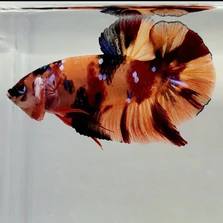Giant betta fish Care
If you have visited a dog store, a chain discount store, or even a florist, lately, you've most likely been drawn to the rich colors and long-finned elegance of the Giant betta fish.Bettas, also known as "Siamese fighting fish" are relatively inexpensive, but exceedingly beautiful. For these reasons, they've recently (and unfortunately) gain popularity not so much as pets, but as decorating accents, as a result of misleading reports that they're meant to thrive in tiny amounts of water and need almost no looking after. However, Giant betta fish care entails a lot more than plunking your brand-new fish right into a wine goblet with a marble or two for company. Taking care of a Giant betta fish requires preparation, education, and compassion. Let this brief tutorial turn you right into a better betta owner!
Possibly the misconception that bettas are "meant" to live in small amounts of water stems from the fact bettas are generally sold in containers no larger when compared to a teacup. Unlike other fish at the aquarium store, bettas are really aggressive towards one another, and cannot be housed with other fish. Since they must be sold separately, they're placed into cups and stacked row upon row to save lots of room. Potential betta owners are then happily informed that the fish needs almost no oxygen or water. The sad simple truth is that numerous bettas die within 2-3 weeks of purchase due either to ammonia buildup within their small habitats or lack of oxygen. With this specific at heart, let the initial item in your Giant betta fish care checklist be a satisfactory tank-at least one gallon, but preferably three or more. With optimum room to swim and an aerator providing fresh oxygen, bettas have been known to live for ten or more years!Please Hit on https://jvbettafishforsale.com/ to get more about Betta Fish.'

When you visit the store to choose your betta, know to start with that nearly every fish will probably be a man, unless otherwise specified. The male bettas are what earned these fish the title "Jewel of the Orient" while the females are remarkably dull and short-finned, by comparison. Most bettas sold in pet stores will soon be around nine months old-just after their fins have lengthened and their mature coloration has arrived. When selecting a betta, search for the healthiest specimen by searching for and avoiding torn fins, dull color patches, and wounds. Most bettas can look extremely droopy because they float within their alloted six ounces of water, but rest assured that whenever you bring them home and introduce them with their new, larger dwelling, they should perk up immediately and start gliding about, unfurling their magnificent fins for you to admire.
When it comes to a betta's diet, moderation is key, as a betta's stomach is approximately as large since the black dot in the middle of his eye! With this at heart, feed your betta one specialty "betta pellet" once a day. For a goody, try giving him a touch of frozen bloodworms about once weekly, as it will help maintain his jewel-bright complexion. Other than taking precaution not to overfeed your betta, the most crucial aspect in Giant betta fish care is water quality. Never place your betta in water straight from the tap! There are numerous products in the marketplace that will instantly make water safe for fish, or you can use bottled spring water. Ensure your betta's tank is kept warm enough (but never placed in direct sunlight!), especially during winter months months. You may get a tiny thermometer, and if needed, a heater made especially for fish tanks, to make sure the water temperature is kept between 75 and 80 degrees Fahrenheit. When changing the water, replace only half the water at any given time, and constantly be sure the replacement water is purified.